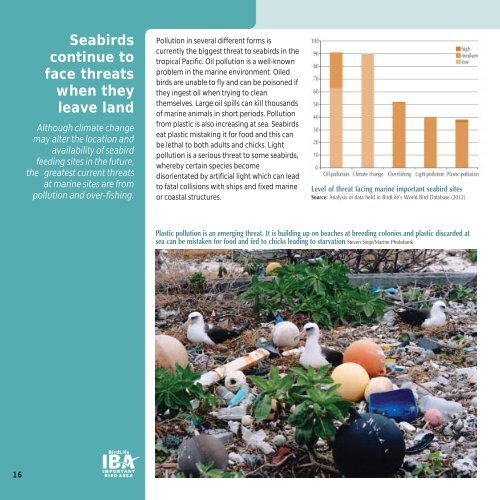Pacific seabirds - BirdLife International
Pacific seabirds - BirdLife International
Pacific seabirds - BirdLife International
Create successful ePaper yourself
Turn your PDF publications into a flip-book with our unique Google optimized e-Paper software.
16<br />
Seabirds<br />
continue to<br />
face threats<br />
when they<br />
leave land<br />
Although climate change<br />
may alter the location and<br />
availability of seabird<br />
feeding sites in the future,<br />
the greatest current threats<br />
at marine sites are from<br />
pollution and over-fishing.<br />
Pollution in several different forms is<br />
currently the biggest threat to <strong>seabirds</strong> in the<br />
tropical <strong>Pacific</strong>. Oil pollution is a well-known<br />
problem in the marine environment. Oiled<br />
birds are unable to fly and can be poisoned if<br />
they ingest oil when trying to clean<br />
themselves. Large oil spills can kill thousands<br />
of marine animals in short periods. Pollution<br />
from plastic is also increasing at sea. Seabirds<br />
eat plastic mistaking it for food and this can<br />
be lethal to both adults and chicks. Light<br />
pollution is a serious threat to some <strong>seabirds</strong>,<br />
whereby certain species become<br />
disorientated by artificial light which can lead<br />
to fatal collisions with ships and fixed marine<br />
or coastal structures.<br />
Level of threat facing marine important seabird sites<br />
Source: Analysis of data held in <strong>BirdLife</strong>’s World Bird Database (2012).<br />
Plastic pollution is an emerging threat. It is building up on beaches at breeding colonies and plastic discarded at<br />
sea can be mistaken for food and fed to chicks leading to starvation Steven Siege/Marine Photobank

















